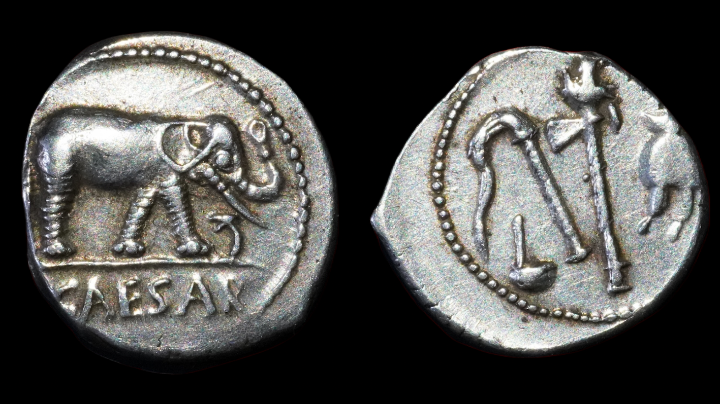The denarius of Julius Caesar featuring the elephant is one of the most famous Roman coins. A symbol of Rome’s grandeur and Caesar’s fierce struggle against the Gauls, this piece of history is a cornerstone of any Roman coin collection. To own this denarius is to hold in your hands a fragment of propaganda and imperial ambition.
A Denarius Rich in Symbolism
This silver coin measures 19 mm in diameter and weighs 3.79 g. It was struck in 49 BC in Italy, at a pivotal moment in Roman history.
In terms of rarity, it is classified as R1, making it a fairly sought-after piece without being out of reach. As for its condition, it boasts a strong preservation: EF (Extremely Fine) for the obverse and VF (Very Fine) for the reverse.
On the obverse, an elephant is depicted marching to the right, trampling a serpent beneath its feet. This highly symbolic scene likely represents Caesar’s triumph over his enemies. The inscription “CAESAR” proudly declares the name of the issuer.
The reverse features various pontifical instruments, highlighting Caesar’s religious role. From left to right, one can identify a simpulum, an aspergillum, a sacrificial axe, and a sacrificial cap—each linked to the sacred rites of Roman religion.

The Man Behind the Coin
Behind this denarius lies far more than just a person—it is a fragment of the boundless ambition of Caius Julius Caesar, better known as Julius Caesar.
Born in 100 BC, he entered politics at a young age, opposing the dictator Sulla and aligning himself with his uncle by marriage, Marius. After steadily climbing the ranks of power, he became praetor in 62 and then consul in 59—the year he formed the famous First Triumvirate with Pompey and Crassus. Thanks to this alliance, he secured command over Gaul, where he led a brutal and victorious military campaign, marked by Gergovia, Alesia, and the fall of Vercingetorix.
But the balance of power shifted: Crassus died, and tensions with Pompey erupted. In 49 BC—the very year this denarius was struck—Caesar crossed the Rubicon, an open act of rebellion against the Senate that marked the beginning of a civil war. He eventually defeated Pompey at Pharsalus and crushed his remaining enemies at Thapsus and Munda.
Having become the most powerful man in Rome, Caesar concentrated power in his hands, fueling fear and jealousy. On the Ides of March in 44 BC, he was assassinated by his former allies, Brutus and Cassius.
But death did not stop him: in 42 BC, he was deified, and his name—engraved on this denarius—was forever inscribed in history. To own this coin is to hold a direct witness to the fall of the Republic and the rise of the Roman Empire.
A Must-Have
Julius Caesar’s elephant denarius is far more than just a coin: it’s a powerful testament to a decisive turning point in Roman history, a work of political propaganda, and an iconic collector’s item.
With its silver strike, powerful symbols, and remarkable state of preservation, this coin combines historical, aesthetic, and numismatic value. It was offered at a price of €1,950.
If you're looking for this coin, just ask—we’ll find it for you.